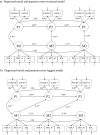Negative cognition, depressed mood, and paranoia: a longitudinal pathway analysis using structural equation modeling
- PMID: 21474550
- PMCID: PMC3446231
- DOI: 10.1093/schbul/sbr019
Negative cognition, depressed mood, and paranoia: a longitudinal pathway analysis using structural equation modeling
Abstract
The role of negative cognition and effect in maintaining psychotic symptoms is increasingly recognized but has yet to be substantiated though longitudinal analysis. Based on an a priori theoretical model, we hypothesized that negative cognition and depressed mood play a direct causal role in maintaining paranoia in people with psychosis and that the effect of mood is mediated by negative cognition. We used data from the 301 patients in the Prevention of Relapse in Psychosis Trial of cognitive behavior therapy. They were recruited from consecutive Community Mental Health Team clients presenting with a recent relapse of psychosis. The teams were located in inner and outer London and the rural county of Norfolk, England. The study followed a longitudinal cohort design, with initial measures repeated at 3 and 12 months. Structural equation modeling was used to investigate the direction of effect between negative cognition, depressed mood, and paranoia. Overall fit was ambiguous in some analyses and confounding by unidentified variables cannot be ruled out. Nevertheless, the most plausible models were those incorporating pathways from negative cognition and depressed mood to paranoid symptoms: There was no evidence whatsoever for pathways in the reverse direction. The link between depressed mood and paranoia appeared to be mediated by negative cognition. Our hypotheses were thus corroborated. This study provides evidence for the role of negative cognition in the maintenance of paranoia, a role of central relevance, both to the design of psychological interventions and to the conceptualizations of psychosis.
Figures



References
-
- Birchwood M. Pathways to emotional dysfunction in first episode psychosis. Br J Psychiatry. 2003;182:373–375. - PubMed
-
- Fowler D. Psychological formulation of early psychosis: a cognitive model. In: Birchwood M, Fowler D, Jackson C, editors. Early Intervention in Psychosis. Chichester, UK: John Wiley and Sons; 2000. pp. 101–127.
-
- Fowler D, Freeman D, Steel C, et al. The catastrophic interaction hypothesis: how do stress, trauma, emotion and information processing abnormalities lead to psychosis. In: Morrison A, Larkin W, editors. Trauma and Psychosis. Chichester, UK: John Wiley and Sons; 2006. pp. 101–124.
-
- Garety PA, Kuipers EK, Fowler D, Freeman D, Bebbington PE. A cognitive model of the positive symptoms of psychosis. Psychol Med. 2001;31:189–195. - PubMed
-
- Garety PA, Bebbington P, Fowler D, Freeman D, Kuipers E. Implications for neurobiological research of cognitive models of psychosis: a theoretical paper. Psychol Med. 2007;37:1377–1391. - PubMed
Publication types
MeSH terms
Grants and funding
LinkOut - more resources
Full Text Sources
Medical

